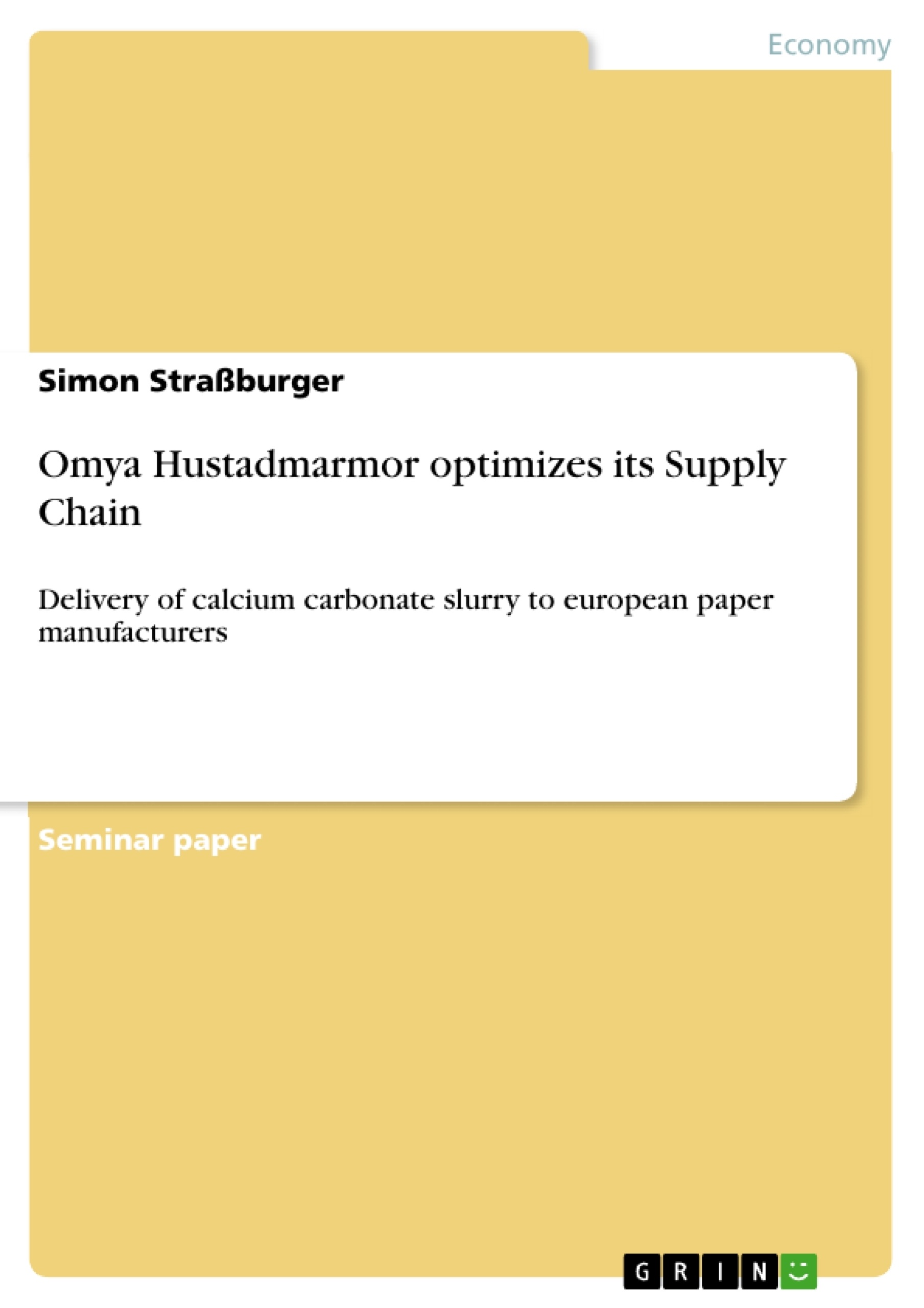This paper addresses a shipments-planning problem faced by Omya Hustadmarmor, a producer of large volume slurry products. From a single producing plant with limited production and tank storage capacity, multiple products
are transported by different vessels to a number of tank farms that also have limited inventory capacity. The objective is to minimize the total distribution cost such that capacity constraints are not violated, i.e. neither stopping
production at the plant, nor running out of stock at the tank farms. This Inventory-Routing Problem is solved by the use of a mixed integer-programming model and the application of a metaheuristic approach to obtain optimal
solutions. At the company, the solution method was implemented successfully in a Decision Support System and resulted in a much more flexible and predictable supply chain. Today’s business environment is characterized by an increasing complexity in manufacturing and supply chain management (Booth 1996). Huge numbers of choices and persistent time and margin pressures make managerial decisions more difficult. In addition, new enterprise applications and software are generating overwhelming amounts of data. Turning this data into
decision-supportive information by applying theoretical models in practice is one of the tasks of Operations Research (Robinson 2000). For almost 35 years, the ‘Institute for Operations Research and Management Sciences’
(INFORMS) honors extraordinary practical achievements and success stories in Operations Research with the ‘Franz Edelman Award’. By bringing together top examples of innovation from different international organizations, the possibilities of Operations Research should be demonstrated and serve as a continuous source for new ideas and optimization. Among the finalists of the 2006 ‘Franz Edelman Competition’ is the European company Omya Hustadmarmor.
Inhaltsverzeichnis (Table of Contents)
- Introduction
- Relevance
- Research Objective and Outline
- About Omya Hustadmarmor
- Company Information
- Supply Chain Management
- Overcoming the Decision Difficulty
- Operational Challenges
- Complexity Drivers in the Supply Chain
- Coherence of Production and Distribution Planning
- The Inventory-Routing-Optimization Problem
- Mixed-Integer Linear Programming
- A Nonlinear Objective Function
- Finding the Solution with a Metaheuristic Method
- The Decision Support System
- Design and Implementation
- Beneficial Effects
- Management Implications
- Innovativeness of the Approach
- Transferability to Other Industries
- Conclusion and Outlook
Zielsetzung und Themenschwerpunkte (Objectives and Key Themes)
This paper examines the approach taken by Omya Hustadmarmor to address the challenges of a complex supply chain. The study analyzes how the company utilized operations research methodologies to develop an innovative Decision Support System (DSS) for maritime inventory routing. The paper aims to explore the practical implementation and benefits of the model, while also considering its potential for transferability to other industries. Here are the key themes explored in this paper:- The challenges of managing a complex supply chain in the context of a growing company like Omya Hustadmarmor
- The development and implementation of a Decision Support System using mixed-integer programming and a metaheuristic approach
- The benefits of using operations research techniques to enhance supply chain efficiency, flexibility, and predictability
- The potential for transferring the developed model to other industries facing similar logistical challenges
- The impact of the DSS on Omya Hustadmarmor's overall operational performance.
Zusammenfassung der Kapitel (Chapter Summaries)
Chapter 1: Introduction
This chapter sets the context for the research by highlighting the increasing complexity of manufacturing and supply chain management in today's business environment. It emphasizes the role of Operations Research (OR) in turning data into decision-supportive information. The chapter introduces Omya Hustadmarmor as a company that has successfully applied OR techniques to overcome its supply chain challenges and its participation in the "Franz Edelman Competition."Chapter 2: About Omya Hustadmarmor
This chapter provides background information on Omya Hustadmarmor, a key player in the European paper industry. It outlines the company's business activities, its growth trajectory, and the challenges it faced in managing its complex supply chain due to its rapidly increasing production output and export-oriented business.Chapter 3: Overcoming the Decision Difficulty
This chapter delves into the operational challenges faced by Omya Hustadmarmor, specifically focusing on the complexities of production and distribution planning. The chapter then introduces the Inventory-Routing-Optimization Problem (IRP) that Omya Hustadmarmor faced. It discusses the theoretical foundation of the IRP, including the use of mixed-integer linear programming and the challenges of a nonlinear objective function. The chapter culminates in a discussion of the development and implementation of a Decision Support System (DSS) that utilizes a metaheuristic approach to find optimal solutions for the IRP.Schlüsselwörter (Keywords)
The primary keywords and focus topics of this text include: supply chain management, operations research, decision support systems, inventory-routing problems, mixed-integer programming, metaheuristic approaches, maritime logistics, calcium carbonate, paper industry, and operational efficiency. The text explores the use of advanced analytical techniques to optimize supply chain performance, particularly in the context of a large-scale producer of mineral additives for the paper industry.- Quote paper
- Dipl.-Kfm. Simon Straßburger (Author), 2007, Omya Hustadmarmor optimizes its Supply Chain, Munich, GRIN Verlag, https://www.grin.com/document/112971



